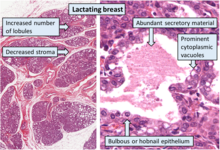Breast engorgement
| Breast engorgement | |
|---|---|
 | |
| Mature female breast engorged during nursing phase |

Breast engorgement occurs in the mammary glands due to expansion and pressure exerted by the synthesis and storage of breast milk. It is also a main factor in altering the ability of the infant to latch-on. Engorgement changes the shape and curvature of the nipple region by making the breast inflexible, flat, hard, and swollen. The nipples on an engorged breast are flat or inverted. Sometimes it may lead to striae on nipples, mainly a preceding symptom of septation mastitis.[1]
Engorgement usually happens when the breasts switch from
Engorgement may lead to
Signs and symptoms
Symptoms include the breasts being swollen and
A fever may occur in 15 percent, but is typically less than 39 degrees C and lasts for less than one day.[3]
Causes
Failure to remove breast milk, especially in the first few days after delivery when the milk comes in and fills the breast, and at the same time blood flow to the breasts increases, causing congestion. The common reasons why milk is not removed adequately are delayed initiation of breastfeeding, infrequent feeds, poor attachment, ineffective suckling,[2] a sudden change in breastfeeding routine, suddenly stopping breastfeeding, or if a baby suddenly starts breastfeeding less than usual.[4]
Treatment
The mother must remove the breast milk. If the baby can attach well and suckle, then she should breastfeed as frequently as the baby is willing. If the baby is not able to attach and suckle effectively, she should express her milk by hand or with a pump a few times until the breasts are softer, so that the baby can attach better,[5] and then get them to breastfeed frequently. She can apply warm compresses to the breast or take a warm shower before expressing, which helps the milk to flow. She can use cold compresses after feeding or expressing, which helps to reduce the oedema. Engorgement occurs less often in baby-friendly hospitals which practise the Ten Steps and which help mothers to start breastfeeding soon after delivery.[2]
Regular breastfeeding can and should be continued.[6] The treatment for breast engorgement can be divided into non-medical and medical methods. The non-medical methods include hot/cold packs, Gua-Sha (scraping therapy),[7] acupuncture and drinking specialized herbal teas[8] whereas medical methods are proteolytic enzymes such as serrapeptase, protease, and subcutaneous oxytocin. Cabbage leaves are often cited as a possible treatment but studies have found they provide "no overall benefit" on breast engorgement.[6] Evidence from published clinical trials on the effectiveness of treatment options is of weak quality and is not strong enough to justify a clinical recommendation.[6]
See also
References
- PMID 27496088.
- ^ a b c "Management of breast conditions and other breastfeeding difficulties". National Center for Biotechnology Information US National Library of Medicine. Retrieved 4 August 2017.
 This article incorporates text from this source, which is in the public domain.
This article incorporates text from this source, which is in the public domain.
- ISBN 978-0-07-179893-8.
- ^ "What is Engorgement? What Causes It?".
- ^ "Warning Signs of Breastfeeding Problems". HealthyChildren.org. Retrieved 29 October 2020.
- ^ PMID 32944940.
- S2CID 18329014.
- ^ "Tackling engorgement and mastitis: an all-in-one guide". www.meandqi.com. Retrieved 26 March 2019.
